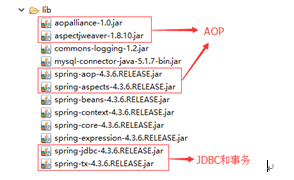Spring事务管理概述
事务管理的核心接口
在 Spring的所有JAR包中,包含一个名为Spring-tx-4.3.6 RELEASE的JAR包,该包就是Spring提供的用于事务管理的依赖包。在该JAR包的 org. springframework.transaction包中,有3个接口文件 PlatformTransaction Manager、 TransactionDefinition和 TransactionStatus。
- PlatformTransactionManager
PlatformTransactionManager接口是Spring提供的平台事务管理器,主要用于管理事务。该接口中提供了3个事务操作的方法,具体如下。
TransactionStatus getTransaction( TransactionDefinition definition):用于获取事务状态信息。该方法会根据TransactionDefinition参数返回一个TransactionStatus对象, Transaction Status对象就表示一个事务,它被关联在当前执行的线程上。
void commit( TransactionStatus status):用于提交事务。
void rollback( TransactionStatus status):用于回滚事务。
PlatformTransactionManager接口只是代表事务管理的接口,它并不知道底层是如何管理事务的,它只需要事务管理提供上面的3个方法,但具体如何管理事务则由它的实现类来完成。
PlatformTransactionManager接口有许多不同的实现类,常见的几个实现类如下。
org. springframework. jdbc. datasource. DataSourceTransactionManager:用于配置JDBC数据源的事务管理器。
org.springframework.orm.Hibernate4.HibernateTransactionManager:用于配置 Hibernate的事务管理器。
org. springframework. transaction. jta. JtaTransactionManager:用于配置全局事务管理器。
当底层采用不同的持久层技术时,系统只需使用不同的PlatformTransactionManager实现类即可。 - Transaction Definition
TransactionDefinition接口是事务定义(描述)的对象,该对象中定义了事务规则,并提供了获取事务相关信息的方法,具体如下。
- String getName():获取事务对象名称。
- int getlsolationLeve():获取事务的隔离级别。
- int getPropagationBehavior():获取事务的传播行为。
- int setTimeout():获取事务的超时时间。
- boolean isReadOnly():获取事务是否只读。

在事务管理过程中,传播行为可以控制是否需要创建事务以及如何创建事务,通常情况下,数据的查询不会影响原数据的改变,所以不需要进行事务管理,而对于数据的插入、更新和删除操作,必须进行事务管理。如果没有指定事务的传播行为, Spring默认传播行为是 REQUIRED。
- TransactionStatus
TransactionStatus接口是事务的状态,它描述了某一时间点上事务的状态信息。该接口中包含6个方法,具体如下。
- void flush():刷新事务。
- boolean hasSavepoint():获取是否存在保存点。
- boolean isCompleted():获取事务是否完成。
- boolean isNewTransaction():获取是否是新事务。
- boolean is RollbackOnly():获取是否回滚。
- void setRollbackOnly():设置事务回滚。
声明式事务管理
基于XML方式的声明式事务
基于XML方式的声明式事务管理是通过在配置文件中配置事务规则的相关声明来实现的。
Spring2.0以后,提供了tx命名空间来配置事务,tx命名空间下提供了<tx: advice>元素来配置事务的通知(增强处理)。当使用<tx: advice>元素配置了事务的增强处理后,就可以通过编写的AOP配置,让 Spring自动对目标生成代理。
配置tx:advice元素时,通常需要指定id和 transaction- manager属性,其中id属性是配置文件中的唯一标识,transaction- manager属性用于指定事务管理器。除此之外,还需要配置一个< tx: attributes>子元素,该子元素可通过配置多个< tx:method>子元素来配置执行事务的细节。


<?xml version="1.0" encoding="UTF-8"?>
<beans xmlns="http://www.springframework.org/schema/beans"
xmlns:xsi="http://www.w3.org/2001/XMLSchema-instance"
xmlns:aop="http://www.springframework.org/schema/aop"
xmlns:tx="http://www.springframework.org/schema/tx"
xmlns:context="http://www.springframework.org/schema/context"
xsi:schemaLocation="http://www.springframework.org/schema/beans
http://www.springframework.org/schema/beans/spring-beans-4.3.xsd
http://www.springframework.org/schema/tx
http://www.springframework.org/schema/tx/spring-tx-4.3.xsd
http://www.springframework.org/schema/context
http://www.springframework.org/schema/context/spring-context-4.3.xsd
http://www.springframework.org/schema/aop
http://www.springframework.org/schema/aop/spring-aop-4.3.xsd">
<!--1.配置数据源 -->
<bean id="dataSource"
class="org.springframework.jdbc.datasource.DriverManagerDataSource">
<!--数据库驱动 -->
<property name="driverClassName" value="com.mysql.jdbc.Driver" />
<!--连接数据库的ur1 -->
<property name="url" value="jdbc:mysql://localhost:3306/db_spring" />
<!--连接数据库的用户名 -->
<property name="username" value="root" />
<!--连接数据库的密码 -->
<property name="password" value="root" />
</bean>
<!--2.配置JDBC模板 -->
<bean id="jdbcTemplate" class="org.springframework.jdbc.core.JdbcTemplate">
<!--默认必须使用数据源 -->
<property name="dataSource" ref="dataSource" />
</bean>
<!--3.定义id为userDao的Bean -->
<bean id="userDao" class="com.ssm.jdbc.UserDaoImpl">
<!--将 jdbcTemplate注入到 userDao实例中 -->
<property name="jdbcTemplate" ref="jdbcTemplate" />
</bean>
<!--4.事务管理器,依赖于数据源 -->
<bean id="transactionManager"
class="org.springframework.jdbc.datasource.DataSourceTransactionManager">
<property name="dataSource" ref="dataSource"/>
</bean>
<!--5.编写通知:对事务进行增强(通知),需要编写对切入点和具体执行事务细节 -->
<tx:advice id="txAdvice" transaction-manager="transactionManager">
<tx:attributes>
<tx:method name="*" propagation="REQUIRED"
isolation="DEFAULT" read-only="false"/>
</tx:attributes>
</tx:advice>
<!--6.编写aop,让spring自动对目标生成代理,需要使用AspectJ的表达式 -->
<aop:config>
<!--切入点 -->
<aop:pointcut expression="execution(* com.ssm.jdbc.*.*(..))" id="txPointCut" />
<!--切面 -->
<aop:advisor advice-ref="txAdvice" pointcut-ref="txPointCut"/>
</aop:config>
</beans>
基于Annotation方式的声明式事务
Spring的声明式事务管理还可以通过 Annotation(注解)的方式来实现。这种方式的使用非常简单,开发者只需做两件事情:
(1)在 Spring容器中注册事务注解驱动,其代码如下。
<tx: annotation-driven transaction-managers ntransactionManager"/>
(2)在需要使用事务的 Spring Bean类或者Bean类的方法上添加注解@Transactional。如果将注解添加在Bean类上,则表示事务的设置对整个Bean类的所有方法都起作用;如果将注解添加在Bean类中的某个方法上,则表示事务的设置只对该方法有效。

<?xml version="1.0" encoding="UTF-8"?>
<beans xmlns="http://www.springframework.org/schema/beans"
xmlns:xsi="http://www.w3.org/2001/XMLSchema-instance"
xmlns:aop="http://www.springframework.org/schema/aop"
xmlns:tx="http://www.springframework.org/schema/tx"
xmlns:context="http://www.springframework.org/schema/context"
xsi:schemaLocation="http://www.springframework.org/schema/beans
http://www.springframework.org/schema/beans/spring-beans-4.3.xsd
http://www.springframework.org/schema/tx
http://www.springframework.org/schema/tx/spring-tx-4.3.xsd
http://www.springframework.org/schema/context
http://www.springframework.org/schema/context/spring-context-4.3.xsd
http://www.springframework.org/schema/aop
http://www.springframework.org/schema/aop/spring-aop-4.3.xsd">
<!--1.配置数据源 -->
<bean id="dataSource"
class="org.springframework.jdbc.datasource.DriverManagerDataSource">
<!--数据库驱动 -->
<property name="driverClassName" value="com.mysql.jdbc.Driver" />
<!--连接数据库的ur1 -->
<property name="url" value="jdbc:mysql://localhost:3306/db_spring" />
<!--连接数据库的用户名 -->
<property name="username" value="root" />
<!--连接数据库的密码 -->
<property name="password" value="root" />
</bean>
<!--2.配置JDBC模板 -->
<bean id="jdbcTemplate" class="org.springframework.jdbc.core.JdbcTemplate">
<!--默认必须使用数据源 -->
<property name="dataSource" ref="dataSource" />
</bean>
<!--3.定义id为userDao的Bean -->
<bean id="userDao" class="com.ssm.jdbc.UserDaoImpl">
<!--将 jdbcTemplate注入到 userDao实例中 -->
<property name="jdbcTemplate" ref="jdbcTemplate" />
</bean>
<!--4.事务管理器,依赖于数据源 -->
<bean id="transactionManager"
class="org.springframework.jdbc.datasource.DataSourceTransactionManager">
<property name="dataSource" ref="dataSource"/>
</bean>
<!--5.注册事务管理器驱动 -->
<tx:annotation-driven transaction-manager="transactionManager"/>
</beans>